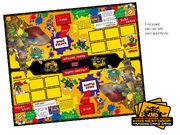The Trading Card Game was made by Wizard of the Coast and released on July 15, 2005.[1] Its simple game mechanic and the many cards make it a fine collection divided into 3 sets.
The Codename: Kids Next Door Trading Card Game "Two-Player Starter Set" and additional booster packs could be found at Target, Toys 'R' Us, and local hobby stores.[2]
The S.O.O.P.E.R.E.V.I.L. booster pack started shipping on December 26, 2005.[3]
Gameplay[]
Basic Game[]

The game playmat
In the basic game, the two players flip a card over from the top of their deck and compare the battle number in the corner. The winning card is placed in the "WINS" area, while the losing card (or both cards in the case of a tie) is returned to the bottom of its owner's deck. The first player with 5 cards in his or her "WINS" area wins the game. The only complication here comes around if both cards are of the same color; in this case, the numbers are irrelevant, and players must instead be the first to slap a panic button located on the game mat.
Advanced Game[]
The advanced game introduces the concepts of turn taking and the treehouse. In addition to a battle number in the top corner, each card contains a small snack icon in the lower right corner. This snack icon represents a resource which can be used to power-up other cards when the card is in the treehouse. Each player begins with a single card in their treehouse, and hence this card supplies a single full snack.
On each player's turn, he or she reveals the top card of his or her deck and decides whether to battle with the card, or to add it to the treehouse (where it stays for the remainder of the game). If a battle is selected, the battle is performed against the (face down) top card of the opponent's deck, so the outcome is not known in advance. During the battle, if either player is able to match the empty snack icons on their battling card to full icons being provided by cards in their treehouse, the card battles at the effective strength of its much higher power-up number, instead of using the battle number as it normally would. Note that the panic button rule from the basic game is also in effect, so players must be ready to react to a matched color at any time.
The victory conditions are the same, with the first player to win 5 battles winning the game. Players can score regardless of who initiated a battle, so it is possible to win at the end of the other player's turn.
Creating cards[]
The product packages for Codename: Kids Next Door Trading Card Game contain a limited number of scene cards and sticker sheets, which are paired up to form custom cards. The scene cards are essentially just cards with a blank power-up area, waiting for one to be attached from a sticker sheet. Sticker sheets also include an equal number of small art stickers, but these are purely decorative, meant to be placed on top of the artwork of the scene card.
Card sets[]

|

|

|
| Base Set | Sooper Evil Set | Time Tangle Set |
| 120 Cards 15 Stickahs |
80 Cards 10 Stickahs |
? Cards ? Stickahs |
| Base Set | S.O.O.P.E.R.E.V.I.L. | T.I.M.E. T.A.N.G.L.E. |
Trivia[]

Early design playmat
- The design for the Codename: Kids Next Door Trading Card Game went through a few stages, with the first definite round focusing more on bright and vibrant colors. This was later changed to focus more on the "spy" theme of the show.[4]
Product designers[]
The following people worked on the Codename: Kids Next Door Trading Card Game.[5]
- Original Game Design: Brian Tinsman (lead), Tyler Bielman, and Teeuwynn Woodruff.
- Game Design and Development: Brian Tinsman (lead), Tyler Bielman, Brandon Bozzi, Jonathan Tweet, and Teeuwynn Woodruff.
- Rules Writing: Brian Tinsman, Brandon Bozzi, and Jessica Kristine
- Editing: Cal Moore and Jessica Kristine
- Art Direction: Paul Hebron
- Graphic Design: Yasuyo Dunnett and Leon Cortez
- Typesetting: Godot Gutierre
- Brand Management: Debbie Uttecht and Sara Girard
- Production Management: Jane Flohrschutz and Stephanie Sharp
- Market Research: Kim Lundstrom and Taryn Obaid
References[]
- ↑ ‘Numbuh One’ Priority: Celebrate Launch of Codename: Kids Next Door Trading Card Game at Kid’s Fest!
- ↑ Wizards of the Coast: Kids Next Door Q&A Page 2 (retreived with Wayback Machine)
- ↑ OCT058088 - CODENAME KND TCG OPERATION SOOPEREVIL BOOSTER DIS
- ↑ Paul Hebron Creative Direction and Design - Kids Next Door Trading Card Game
- ↑ Wizards of the Coast: Kids Next Door Q&A Page 2 (retreived with Wayback Machine)
